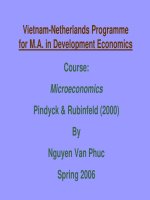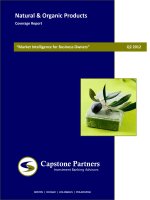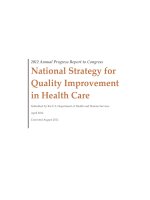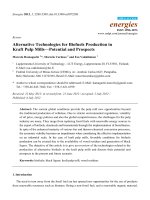NATIONAL PROGRAMME FOR ORGANIC PRODUCTION pdf
Bạn đang xem bản rút gọn của tài liệu. Xem và tải ngay bản đầy đủ của tài liệu tại đây (672.08 KB, 238 trang )
First Edition: May 2001
Second Edition: January 2002
Third EditionConsolidated Version: November 2002
Fourth Edition: June 2003
Fifth Edition: June 2004
Sixth Edition: May 2005 (edited in September 2005)
TABLE OF CONTENTS
Page No.
SECTION - 1
DEFINITIONS
1-15
SECTION - 2
SCOPE AND OPERATIONAL STRUCTURE OF NATIONAL
ORGANIC PROGRAMME
2.1 SCOPE
16
2.2 STRUCTURE
17
2.2.1
2.2.2
2.2.3
2.2.4
2.2.5
Operational Structure
National Accreditation Body
Evaluation Committee
Accredited Inspection and Certification Agencies
Inspectors
17
18
20
20
20
SECTION - 3
NATIONAL STANDARDS FOR ORGANIC PRODUCTION
3.1
21-23
23
24
Crop production
25
3.2.1
3.2.2
3.2.3
3.2.4
3.2.5
3.2.6
3.2.7
3.2.8
3.3.
21
3.1.1 Conversion requirements
3.1.2 Maintenance of organic management
3.1.3 Landscape
3.2
Crop production and animal husbandry in general
25-24
26-27
27-28
28-30
30-32
33
34-35
35-36
Choice of crops and varieties
Length of conversion period
Diversity in crop production
Fertilisation policy
Pest, disease and weed management including growth regulators
Contamination control
Soil and water conservation
Collection of non cultivated material of plant origin and honey
Animal husbandry
36
3.3.1 Animal husbandry management
3.3.2 Length of conversion period
3.3.3 Brought-in animals
36-38
38-39
39-40
3.3.4
3.3.5
3.3.6
3.3.7
3.3.8
3.3.9
3.4
Breeds and breeding
Mutilations
Animal nutrition
Veterinary medicine
Transport and slaughter
Bee keeping
40-41
41-42
42-46
46-48
48-50
50-52
Food processing and handling
52
3.4.1
3.4.2
3.4.3
3.4.4
3.4.5
52-54
54-55
55-56
57-58
58
General
Pest and disease control
Ingredients, additives and processing aids
Processing methods
Packaging
3.5
Labelling
59-61
3.6
Storage & transport
61-62
SECTION – 4
ACCREDITATION OF INSPECTION AND CERTIFICATION AGENCIES
A.
ACCREDITATION REGULATIONS
63
1.
Short Title & Commencement
63
2.
Scope Of Accreditation
63-64
3.
Committee For Accreditation
64
4.
Application For Accreditation
65
5.
Accreditation Fee
65
6.
Allocation Of Accreditation Number
65
7.
Approval/Non-Approval Of Accreditation
66
8.
Accreditation Contract
66
9.
Updation & Renewal Of Accreditation
67
10.
Power To Issue Guidelines
68
11.
Logo
68
12.
Use Of Logo
68
13.
Suspension/Termination Of Accreditation
68-69
14.
Appeals And Revision Of Award On Appeals
69
15.
Amendment To Regulation
69
16.
Jurisdiction
69
17.
Categories For Accreditation
70
18.
Reciprocity
70
18.1
18.2
70
70-71
19.
National
International
Standards
71
19.1
19.2
19.3
71
71
72
The National Standards for Organic Products
Guidelines for Organic Production and Processing
Package of Practices
20.
Issue Of Certificates
72
B.
ACCREDITATION CRITERIA
72
1.
Application Of The Criteria
72-73
2.
Revision Of Accreditation Criteria
73-74
3.
General Accreditation Criteria
74
3.1
3.2
3.3
3.4
3.5
3.6
3.7
3.8
3.9
3.10
74
75
75
75
75
75
76
76
76
76
Competence
Independence
Accountability and Responsibility
Objectivity
Credibility
Quality Improvement and Internal Review
Access to Information
Confidentiality
Participation
Non-discrimination
4.
Specific Criteria For Accreditation
76-77
5.
General Provisions For Inspection And Certification
Agencies
77
5.1
5.2
5.3
5.4
5.5
Application of Procedures
Adherence to Regulations
Registration
Structure
Regulation on Conflict of Interest
5.5.1 Declarations of interest
5.5.2 Signed agreements
5.5.3 Exclusion
5.5.4 Payment of fees
5.6
Confidentiality
5.7
Other Functions of the Certification Agency
5.7.1 General
5.7.2 Consultancy services provided to operators
5.7.3 Marketing activities
5.8. Equity in Access and Non Discrimination
5.9. Membership Organisations
5.10 Public Information
77
77
77
78
78
78
78
79
79
79
80
80
80
80-81
81
81
82
Management
82
6.1
6.2.
6.3
6.4
6.5
6.6
82-83
83
83
84
84
85
6.
7.
General
Personnel
Subcontracting
Documentation and Documents Control
Records
Quality Management and Internal Review
85
7.1 General
7.2 Standards Review
8.
Standards
85
85-86
Inspection
86
8.1
8.2
8.3
8.4
86
86-87
88-89
89
89
90
90-91
91
91
91-92
8.5
8.6
General
Assignment
Inspection Visit and Report
Methods and Frequency
8.4.1 Inspection frequency
8.4.2 Inspection methods
Analysis and Residue Testing
Inspection Regime for Part Conversion and Parallel Production
8.6.1 Provisions for part conversion in production and processing
8.6.2 Provisions for parallel production
8.7
9.
Inspection for Use of Genetically Engineered Products
92-93
Certification
93
9.1
93
93-94
94-95
95
95
95-96
96
96-97
97
98
98
98-99
99
99
100
9.2
9.3
9.4
9.5
9.6
The Responsible Body and Certification Decisions
9.1.1 Exceptions
The Certification Process
Appeals
Certification Records and Reports
9.4.1 Operator files
9.4.2 Records
9.4.3 Annual certification report
Integrity of the System
9.5.1 Disciplinary measures
9.5.2 Withdrawal of certification
Marks and Certificates
9.6.1 Certificate of registration
9.6.2 Transaction certificate
9.6.3 Product certificate
10. Licensed Operators
10.1 Information to the Licensees
10.2 Records and Documentation Maintained by the Licensee
11. Inspection And Certification Of All Stages In
Handling
11.1
11.2
11.3
11.4
Packed Products
Storage Companies
Transport Companies
Chain of Custody
100
100-101
101
101-102
102
102
102
103
12. Inspection And Certification Of Wild Products
103-104
13. Inspection And Certification Of Input Manufacturing
104
13.1 Approval Systems
14. Inspections and Certification of Grower Groups
14.1 Evaluation of the internal control system
14.2 Grower group records
14.3 Responsibility and sanctions
104
105
105
106
106
15. Certification Systems
106-107
16. Certification Transference
107
16.1 General Certification Transference
16.2 Re-certification
16.3 Certification partnerships
107-109
109
109
17. Complaints
109-110
C.
110
ACCREDITATION PROCEDURES
1.
Background
110
2.
Scope
110
2.1
Inspection and Certification Agencies
110-111
3.
Conflict Of Interest
111-112
4.
Standards
112
4.1
4.2
112
112
General
Standards Review
5.
Accreditation Contract Period
112
6.
Use Of Accreditation Status
113
7.
Fee
113
8.
Amendments
114
9.
Review Of The Accreditation Programme
114
10.
Complaints
114-115
11.
Application, Evaluation And Accreditation
Procedures
115
11.1
115
11.2
11.3
11.4
11.5
12.
Procedure for the Accreditation of Inspection and
Certification Agencies
Application and Screening Procedures
Evaluation and Assessment
Accreditation Procedures
Annual Surveillance and Review Evaluations
Complaints
115-116
116-120
120-121
121-122
122-123
13.
Sanctions
123
14.
Termination Of Accreditation
123-124
15.
Appeals
124
SECTION – 5
GUIDELINES FOR CERTIFICATION OF GROWER GROUPS
5.1
SCOPE
125
5.2
CONSTITUTION OF THE GROUP ORGANIZATION
125
5.3
INTERNAL QUALITY SYSTEM
125-126
5.4
HOW TO DEVELOP AN IQS
126
5.4.1 Internal Quality System Manager (IQS Manager)
5.4.2 Internal Inspectors
5.4.3 Approval Manager / Committee
5.4.4 Field Officers
5.4.5 Purchase Officers
5.4.6 Warehouse Manager
5.4.7 Processing Manager
126
127
127
127
127
127
128
5.5
INTERNAL STANDARDS
128
5.6
CONFLICT OF INTEREST
128
5.7
SCOPE OF CERTIFICATION
129
5.8
TRADE
129
5.9
PROCEDURES FOR IMPLEMENTATION OF INTERNAL
CONTROL SYSTEM
129
5.9.1
5.9.2
129
129-130
Registration of New Members
Provision of the Document to the Members of The Grower Group
5.10
OPERATING DOCUMENT
130-131
5.11
INTERNAL INSPECTIONS
131
5.12
EXTERNAL INSPECTIONS
132
5.13
YIELD ESTIMATES
133
5.14
5.15
INTERNAL APPROVALS
NON-COMPLIANCES AND SANCTIONS
133
133-134
5.16
TRAINING OF IQS PERSONNEL
134
5.17
TRAINING OF FARMERS
134
5.18
BUYING PROCEDURES
134-135
5.19
STORAGE AND HANDLING PROCEDURES
135
5.20
PROCESSING
135
SECTION – 6
ORGANIC CERTIFICATION MARK
5.1
ORGANIC LOGO
136
5.2
SPECIFICATIONS
136
5.3
CONCEPT OF ORGANIC LOGO
137
5.4
REGULATIONS FOR GRANT OF LICENCE TO USE
CERTIFICATION MARK FOR ORGANIC PRODUCTS
137-157
SECTION – 7
APPENDICES
Appendix 1
Products for use in fertilising and soil conditioning
158
Appendix 2
Products for plant pest and disease control
162
Appendix 3
Criteria for evaluation of additional inputs to organic agriculture
165
Appendix 4
List of approved ingredients as additives and processing
171
aids used in processing of organic food
Appendix 5
Criteria for evaluation of additives and processing aids for
178
organic food products
Appendix 6
Approved additives for manufacture of packaging films for packaging
181
of organic foodstuffs
Appendix 7
List of approved feed materials, feed additives, and processing
aids for animal nutrition
182
Appendix 8
Products authorized for cleaning and disinfection of
185
Appendix 9
livestock buildings and installations
Mandatory checks to be undertaken by the accredited
inspection and certification agency during inspection
186
Appendix 10 Precautionary measures to be taken during inspection
and certification of imported agricultural products /
processed food stuffs of plant origin
192
SECTION - 8
FORMATS
195-226
*****
SECTION – 1
DEFINITIONS
ACCREDITATION:
Accreditation means Registration by the National Accreditation Body for certifying
organic farms, products and processes as per the National Standards for Organic Products
and as per the guidelines of the National Accreditation Policy and Programme for organic
products.
ACCREDITED PROGRAMME:
Means programme of accrediting Inspection and Certification Agencies which have been
accredited by the Accreditation Agency and which have agreed to comply with the
Accreditation contract.
ANNUAL REPORT:
Means the report on operators, products and processors submitted annually to the
Accreditation Agency by the accredited Inspection and Certification Agencies.
1
APPEAL:
Shall be the process by which an Inspection and Certification Agency can request
reconsideration of a decision taken by the Accreditation Agency or an operator can
request reconsideration of a decision by the Certification Agency.
APPLICANT:
Shall be the Inspection and Certification Agency that has applied for Accreditation to the
Accreditation Agency.
AYURVEDA:
Ayurveda is a traditional naturopath system of medicines and health care of India.
BUFFER ZONE:
A clearly defined and identifiable boundary area bordering an organic production site that
is established to limit application of, or contact with, prohibited substances from an
adjacent area.
CERTIFICATE:
Would mean a document issued by an accredited agency declaring that the operator is
carrying out the activities or the stated products have been produced in accordance with
the specified requirements in accordance with the National Standards for Organic
Products.
2
CERTIFICATE OF REGISTRATION:
Shall mean the document issued by the Inspection and Certification Agency, declaring
that the operator is licensed to use the certificate on specified products.
CERTIFICATION:
Shall be the procedure by which a written assurance is given by the Certification Agency
that a clearly identified production or processing system has been methodically assessed
and conforms to the specified requirements.
CERTIFICATION MARK:
Shall mean certification programme’s sign, symbol or logo which identifies the products
as being certified according to the National Standards for Organic Products.
CERTIFICATION PROGRAMME:
Shall mean the system operated by an Inspection and Certification Agency in accordance
with the criteria for carrying out certification of conformity as laid down herein.
CERTIFICATION TRANSFERENCE:
The formal recognition by an Inspection and Certification Agency of another
Certification programme or Agency or projects or products certified by that programme
or Agency, for the purpose of permitting its own certified operators to trade or process
under the programme’s own certification mark, the products which are certified by the
other programme.
3
CHAIN OF CUSTODY:
All relevant steps in the production chain including growing, harvesting, processing,
handling and related activities detailed in Section 4 of the accreditation criteria that have
been inspected and certified, as appropriate.
COMPETENT AUTHORITY:
Shall mean the official government agency for accreditation.
CONTAMINATION:
Pollution of organic product or land; or contact with any material that would render the
product unsuitable for organic certification.
CONSULTANCY:
Shall mean the advisory service for organic operations, independent from inspection and
certification procedures.
CONVENTIONAL:
Farming systems dependent on input of artificial fertilizers and/or chemicals and
pesticides or which are not in conformity with the basic standards of organic production.
CONVERSION:
The process of changing an agricultural farm from conventional to organic farm. This is
also called transition.
4
CONVERSION PERIOD:
The time between the start of organic management, and the certification of crops as
organic.
DECLARATION OF INTEREST:
Declaration of no personal / commercial conflict of interest by all concerned involved in
the process of inspection and certification.
DISINFECTANT:
A product that minimizes by physical or accepted chemical means, the number of
microorganisms in the environment, to a level that does not compromise food safety and
suitability.
EVALUATION:
Shall be the process of systematic examination of the performance of an Inspection and
Certification Agency to meet the specific requirements under the National Accreditation
Programme.
FARM UNIT:
An agricultural farm, area or production unit managed organically, by a farmer or a group
of farmers.
5
FOOD ADDITIVE:
Food additive is an external permissible ingredient added to improve the keeping quality,
consistency, colour and other physico chemical, sensory properties, wholesomeness and
safety of food
GENETIC DIVERSITY:
Genetic diversity means the variability among living organisms from agricultural, forest
and aquatic ecosystem. This includes diversity within species and between species.
GREEN MANURE:
Manure consisting of fresh green plant matter, which is ploughed in or turned into the soil
for the purpose of soil improvement.
GROUP CERTIFICATION:
Certification of an organized group of producers, processors and exporters with similar
farming and production systems and which are in geographical proximity.
GUIDELINES FOR ORGANIC PRODUCTION AND PROCESSING:
Standards for organic production and processing established by the Accreditation
Agencies for specific crops in accordance with the National Standards for Organic
Products.
HABITAT:
The area in which a plant or animal species naturally exists.
6
HAZARD ANALYSIS CRITICAL CONTROL POINT (HACCP):
A systematic process that identifies food safety hazards, critical control points, critical
limits, corrective actions and documentation and integrates monitoring procedures to
ensure food safety.
OR
The Hazard Analysis Critical Control Point (HACCP) system is a science based on
systematic approach to producing safe food. Food safety management systems based on
HACCP are internationally recognized as the most effective way to ensure food safety
and minimize the risks of food poisoning.
HOMEOPATHY:
Homeopathy is a system of medicine based on the principle of “Similia, Similibus,
Curentur (let likes be treated by likes)”.
HOMEOPATHIC TREATMENT:
Treatment of disease based on administration of remedies prepared through successive
dilution of a substance that in larger amounts produces symptoms in healthy subjects
similar to those of the disease itself.
INGREDIENT:
Shall mean any substance, including a food additive, used in the manufacture or
preparation of a food and present in the final product although possibly in a modified
form.
7
INPUTS BANNED:
Those items, the use of which is prohibited in organic farming.
INPUT MANUFACTURING:
Shall mean the manufacturing of organic production or processing inputs.
INPUTS PERMITTED:
Those items that can be used in organic farming.
INPUTS RESTRICTED:
Those items that are allowed in organic farming, in a restricted manner, after a careful
assessment of contamination risk, natural imbalance and other factors arising out of their
use. Farmers should consult the certifying agency.
INSPECTION:
Shall include the site visit to verify that the performance of an operation is in accordance
with the production or processing standards.
INSPECTION AND CERTIFICATION AGENCY:
Shall be the organization responsible for Inspection and Certification.
8
INSPECTION AGENCY:
Shall mean the agency that performs inspection services as per the National Accreditation
Policy and Programme.
INSPECTOR:
Shall be the person appointed by the Inspection and Certification Agency to undertake
the inspection of an operator.
INTERNAL CONTROL SYSTEM:
A documented quality assurance system that allows the external certification body to
delegate the inspection of individual group members to a body identified from within the
operators of the group.
INTERNAL REVIEW:
Shall mean an assessment of the objectives and performance of a programme by the
Certification or the Accreditation Agency itself.
IRRADIATION:
High energy emissions from substances for the purpose of controlling microbial,
pathogens, parasites and pests in food, preserving the food or inhibiting physiological
processes such as sprouting or ripening.
9
LABELLING:
Means any written, printed or graphic matter that is present on the label, accompanies the
food, or is displayed near the food, including that for the purpose of promoting its sale or
disposal.
LICENCE:
Shall be the Accreditation contract that grants a certifier the rights associated with its
accredited status in line with the National Program for Organic Production.
LIVESTOCK:
Shall mean any domestic or domesticated animal including bovine (including buffalo and
bison), bovine, porcine, caprine, equine, poultry and bees raised for food or in the
production of food. The products obtained by hunting or fishing of wild animals shall not
be considered as part of this definition.
MARKETING:
Means holding for sale or displaying for sale, offering for sale, selling, delivering or
placing on the market in any other form.
MULTIPLICATION:
The growing of seed / stock / plant material to supply for future production
NATIONAL ACCREDITATION BODY (NAB):
Shall be the agency set up by the Steering Committee for National Programme for
Organic Production for accrediting Inspection and Certification Agencies.
10
NATURAL FIBRE:
A filament of plant or animal origin.
OPERATOR:
Shall mean an individual or a business enterprise practicing organic farming or organic
processing.
ORGANIC:
Refers to a particular farming system as described in these standards and not to the term
used in chemistry.
ORGANIC AGRICULTURE:
It is a system of farm design and management to create an eco system, which can achieve
sustainable productivity without the use of artificial external inputs such as chemical
fertilizers and pesticides.
ORGANIC PRODUCTION UNIT:
Shall mean a unit / holding or stock farm complying with the rules of NPOP regulations.
ORGANICALLY-PRODUCED FEEDING STUFFS / FEED MATERIALS:
Shall mean feeding stuffs / feed material produced in accordance with the rules of
production laid down in NPOP regulations.
ORGANIC SEEDS AND PLANTING MATERIAL:
Seed and planting material produced under certified organic system.
11
PACKAGE OF PRACTICES:
Guidelines for organic production and processing established by the Accreditation
Agencies for specific crops, specific to the region.
PARALLEL PRODUCTION:
Shall mean any production where the same unit is growing, breeding, handling or
processing the same products both in a certified organic and a non-certified organic
system. Similarly a situation with “organic” and “in conversion” production of the same
product is also parallel production.
PART CONVERSION:
Shall be when part of a conventional farm or unit has already been converted to organic
production or processing and a part is in the process of conversion.
PLANT PROTECTION PRODUCT:
Shall mean any substance intended for preventing, destroying, attracting, repelling, or
controlling any pest or disease including unwanted species of plants or animals during the
production, storage, transport, distribution and processing of food, agricultural
commodities, or animal feeds.
PREPARATION:
Shall mean the operations of slaughtering, processing, preserving and packaging of
agricultural and animal products and also alterations made to the labeling concerning the
presentation of the organic production method.
12
PROCESSING AIDS:
A substance or material not consumed as a food ingredient by itself but used in the
processing of raw materials, food or its ingredients to fulfil a certain technological
purpose during treatment or processing and which may result in unintentional but
unavoidable presence of residues or derivatives in the final product.
QUALITY SYSTEM:
Documented procedures, which are established, implemented, and periodically audited to
ensure that production, processing, handling, management, certification, accreditation
and other systems meet the specified requirements and outcomes by following
standardized protocols.
RAW MATERIALS:
All ingredients other than food additives.
SANITIZE:
To adequately treat the produce or food-contact surfaces by a process that is effective in
destroying or substantially reducing the numbers of vegetative cells of micro organisms
of public health concern, and other undesirable micro organisms, but without adversely
affecting the safety and quality of the product.
13









